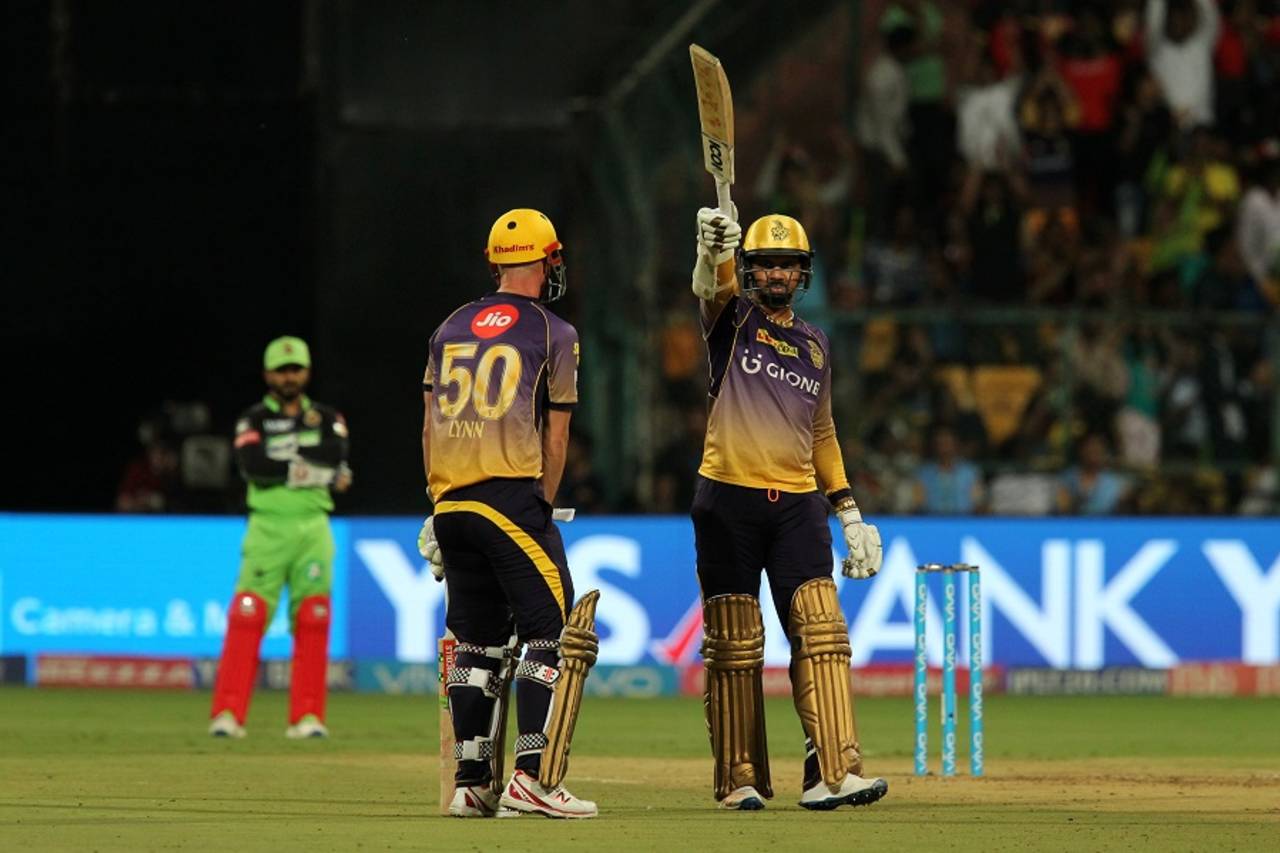The method behind Sunil Narine's madness
The West Indian's devastating ability to hit straight in the Powerplay - when teams rarely employ a long-off or long-on - has brought him great rewards
Akshay Gopalakrishnan in Bengaluru
07-May-2017

Sunil Narine's first T20 fifty was also the joint-fastest in IPL history • BCCI
When Chris Lynn dislocated his shoulder after just two matches in IPL 2017, it seemed as if Kolkata Knight Riders' most logical move was to partner Robin Uthappa with Gautam Gambhir at the top of the order. After all, they are second only to Shikhar Dhawan and David Warner among the most prolific opening combinations in IPL history.
KKR, however, thought differently and handed a promotion to a rather unlikely candidate: Sunil Narine. It wasn't entirely surprising, given he had opened for Melbourne Renegades in the Big Bash League earlier this year. His batting credentials had received a significant boost in the Pakistan Super League as well, where his 116 runs in eight matches came at a strike rate of 181.
Even so, Narine was originally seen as nothing more than a pinch-hitter. With 194 runs off 103 balls in the nine IPL matches as opener, with a strike-rate of 188.34, he has become a power hitter. That fact was further substantiated when he reeled off a 15-ball fifty, the joint-fastest in IPL history, against Royal Challengers Bangalore.
Not only did Narine strike them big and clean, he did so with a calm head, terrific balance and impeccable timing. There was a certain insouciance in his strokeplay, as if he always knew he could bat like a proper top-order player.
His hat-trick of sixes against Samuel Badree showed how well he was able to pick length and read angles. The legspinner kept floating them up and the batsman kept clearing the long-off boundary, even if he wasn't always fully forward. Badree made it worse for himself by firing away googlies outside off, offering Narine the requisite room to open up. But the swing of the bat was never violent.
S Aravind didn't fare much better, even if he managed the odd variation. Having watched his length balls being hammered through mid-off and mid-on, he tried bowling a bit shorter, but still Narine was able to shift his weight back, and instead of going for an orthodox shot - the pull - which would have found the man in the deep, he slapped a four through mid-off. It was classy batting.
According to HawkEye data, 59 out of 116 balls that Narine has faced this IPL has been on a length or fuller. Match that to his most effective shots - he has amassed 140 of his 194 runs through drives - and it reveals a pattern. Bowlers have bowled to his strengths and Narine has feasted on them.
The midwicket region has been the most productive for left-handed batsmen in the Powerplay overs this IPL, followed by the covers. Narine, on the other hand, heavily favours mid-off - where he has blasted 69 runs off 18 balls - and mid-on - 36 off 13 balls. This penchant to hit in the V is why he has been so successful.
Unlike in the death overs when a long-on and long-off are standard boundary-riding positions, rarely are two fielders stationed there during the Powerplay. Additionally, a bowler with the new ball will either pitch it up while it is nipping around, or hit the deck as hard as he can. Captains, therefore, tend to post men on the square boundaries or behind the wicket. And Narine targets the ones that are unmanned; the ones he likes to access.
So how does a team stop Narine? Well, he has not been especially comfortable against the short ball. Pitch map data shows he has faced 14 of them and fallen three times. While he gets over two runs per ball on the pull, it has also claimed his wicket twice, and his control percentage on that shot is only 58. Hitting the blockhole may also not be a bad option - he has perished to two out of the four yorkers bowled to him. RCB could do neither.
And if Narine in full flow wasn't enough, Lynn has also been a rampaging presence at the top for KKR. He set the tone for the chase with 14 runs off the first over from Aniket Choudhary, 10 of which came down the ground. So dominant were the two batsmen that the KKR fifty took all of 11 minutes, and by the end of the sixth over, they had shellacked 105, the highest Powerplay score in IPL history.
Sunday's blitz exemplified how KKR have uncorked a winning formula with Narine. When he fires, they reap wild benefits and when he doesn't, it isn't a big deal, because he rarely ever eats up dots. That, in T20 cricket, is the definition of a gun player.
Akshay Gopalakrishnan is a sub-editor at ESPNcricinfo